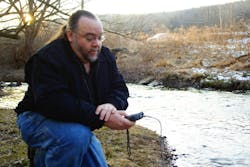Private well owners and small system users commonly say, "My water looks good, tastes good, so it must be good." The problem is that often, private well owners are wrong, and the "good" water has at least one contaminant that could make them sick. In 1989, the Water Research Center (WRC) was founded to gather information on well water quality. After one year and a few hundred water quality samples, the center learned the following:
- Private wells are not regulated by the U.S. Environmental Protection Agency and not uniformly regulated by state agencies or health departments.
- With exception of real estate transfers, formal well water quality tests are not required.
- Most homeowners reported that well water testing was conducted by companies offering free water tests.
- The U.S. Geological Survey estimates that 70 percent of private wells violated at least one drinking water standard. Contamination from septic systems and barnyard waste were primary causes.
- Most common water quality problems were related to bacteria, nuisance odors, corrosive water, iron and manganese.
- When a private water source was treated, the most common problems were related to the improper selection of a treatment system, bacterial regrowth, poor well placement or construction, and poor maintenance.
Based on these findings, the education program focused on the combined role of water source, surface activity, regional land use, aesthetic water quality issues and geology. Borrowed from the phrase "We all live downstream," a Groundwater Guardian Community was formed to build local support and interest. The effort focused on issues that private well owners could see, taste, smell and touch.
The program used an honest broker with fact-based information as opposed to scare tactics. The Homeowner Outreach Program provides private well owners and city water users with opportunities to have someone review their water quality data, listen to their problems and observations, and provide them with customized action items. The programs show that end users were not familiar with the water quality jargon used by water quality professionals. To provide a bridge, the Online Water Quality Help Guide was created. It evolved into the Water Research Center Web portal. Water dealers and other treatment professionals can use programs like these to help educate their clients and assist in making a decision about the ideal system for their contaminants.
In the late 1990s, the interest shifted from groundwater to surface water quality, so the educational program expanded to show the community how surface water and groundwater were connected. A plastic groundwater sand box model was used to demonstrate this. Colored dye was added to the model so people could see how water moves beneath their feet. This exposed users to the concept of recharge zones, discharge zones and watersheds. By linking the private well to the larger watershed, the project showed how surrounding land use can influence water quality. In 2011, the WRC published its first booklet titled "Your Private Well: What Do the Results Mean?"
How to test drinking water
The options for testing drinking water include self-screening tests, informational water testing carried out by laboratories, universities and certified water testing services. These testing options have a place and can be used to effectively monitor water quality. Certified water testing using third party samplers should be used for all legal situations, real estate transactions or testing that is for a regulatory submission. Information water testing can be an affordable alternative when certified testing is not required, but accurate results are needed. This is best used to evaluate the need or performance of a water treatment system. Self-screening testing should be used only after certified or informational testing has been conducted.
How frequently?
For a private or unregulated water source, an initial comprehensive screening test is recommended with quarterly screening during the first year. After the first year, an annual water test for specific parameters of concern based on vulnerability, surroundings, hazards and personal health issues is recommended. For a water treatment system, using self-screening tests as part of the regular maintenance is recommended, and an annual water test of the treated and untreated water is recommended.
What parameters?
Homeowners and private well owners frequently do not realize the cost for water testing. They are often not prepared to conduct a comprehensive, certified water quality test and may be only familiar with the basic total coliform test. Dealers can ask a few questions to better assist their customers:
- What are the concerns related to health and infrastructure within the home?
- What are the regional or environmental concerns?
- Identify the potential hazards in the general vicinity of the well, such as a septic system, agricultural activity, pipelines, oil and gas development and/or gasoline stations, and the historic use of the land.
- Does the water have any aesthetic or use problems?
A basic water quality test should include pH, conductivity, total dissolved solids, alkalinity, total hardness, total coliform bacteria, E. coli, turbidity and nitrate+nitrite. The selection of the best water testing package is specific to each source and user. Because of the costs associated with certified testing and the limited data for a region, a combination of certified and informational water testing for the initial assessment can be effective. Certified testing can meet the requirements for real estate, but informational testing would provide a more comprehensive assessment of the source. The results of the testing should be used as a guide and must be reviewed by an expert.
Is a problem present?
Before installing any water treatment system, dealers should conduct a water quality test. They should review the water quality data and attempt to link the findings to any aesthetic or other problems the homeowner may have. The most common water quality problem is the presence of total coliform. For a well water source, this problem can be addressed by inspecting the well, installing a sanitary well cap and properly shock disinfecting the source.
For municipal water customers, the water company or authority provides an annual water quality report, which provides a summary of information about water sources, treatment and water quality. In general, the most common problems with municipal water are the occasional nuisance issues and concerns with disinfection byproducts. In either situation, a water treatment professional can provide value for his/her clients by identifying quality issues with initial and periodic testing. WT
Brian Oram is the owner of B.F. Environmental Consultants Inc. in Dallas, Pennsylvania, and author of "Pennsylvania Water Quality Your Private Well: What Do the Results Mean?" He has a Master of Science degree from Pennsylvania State University in environmental pollution control and a Bachelor of Science degree from Wilkes University in earth and environmental sciences. Oram is a licensed professional geologist, well driller, soil scientist, licensed sewage enforcement officer and expert in drinking water quality, water treatment and community-based education outreach programs with about 30 years of experience. Visit the WRC website portal and the Know Your H2O? website and phone app (knowyourh2o.us) for assistance. Oram may be reached at [email protected].


